It has been more than a year since I discovered Bangalore University’s bio-park. Spread over 1300 acres, the wilderness area lies adjacent to Mysore Road and the Bangalore-Mysore Railway line. The large area was daunting at first, and it took a while for the landscape to reveal itself to me.
Over time I figured out the areas where the birds are – a rainwater pond and a ground-water discharge pond. And more importantly, the areas where the spiders live. It was a small matter to be ignored that I regularly saw the rarer species of spiders and birds outside of areas where I had slotted them to be, but it gave me a sense of order to understand the landscape. It was like trying to learn an entirely new language – you start with a vocabulary of a few words hoping to expand it over time.
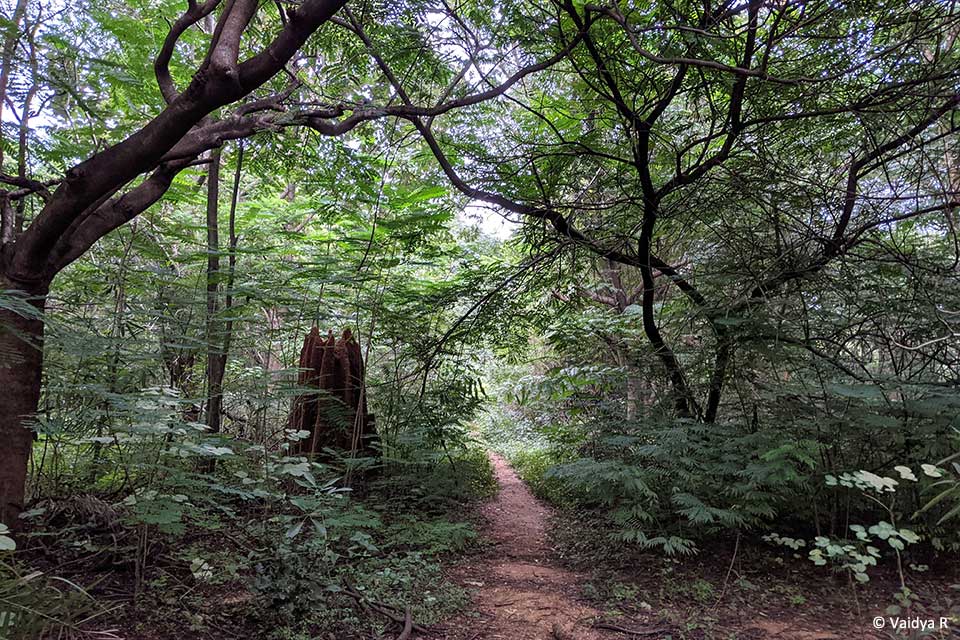
The wilderness in Bangalore University’s bio-park
And over a year later, the vocabulary has been expanding, while much remains hidden. I walk slowly, slower with each passing day, wondering if every dangling twig could be a spider. Most of the time it is a twig, or as a friend joked “a spider-mimicking twig”; just once it was a Miagrammopes sp., a twig-mimicking spider of the family Uloboridae. They look like thin twigs and lie hidden in single strands of silk. You sometimes need to poke every twig you see to spot that one spider.
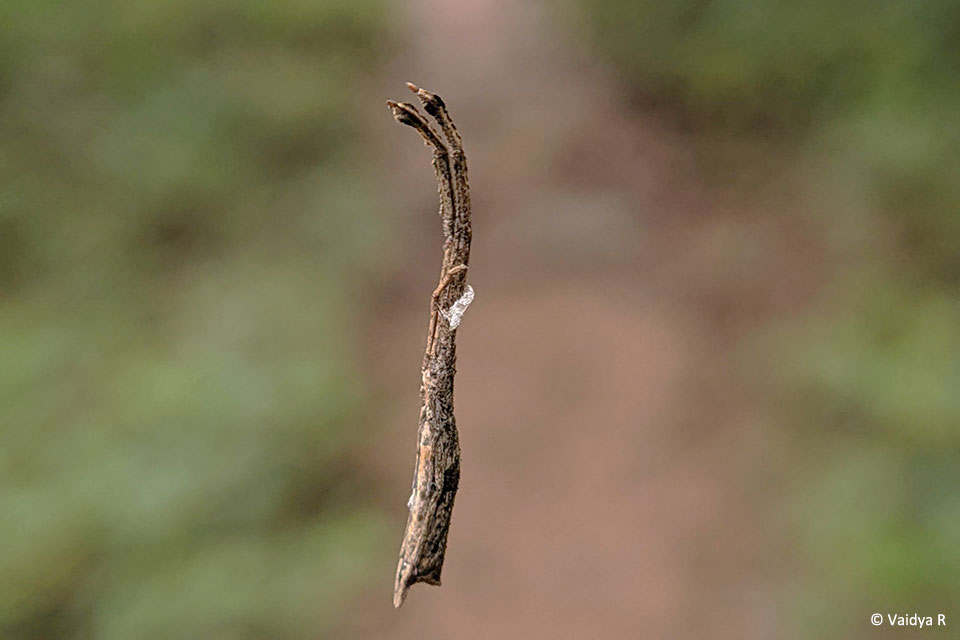
Miagrammopes sp., a twig-mimicking spider
A weaver ant was seen dangling once right next to a path that is frequented by walkers, which I usually avoid. Ants don’t produce silk, at least not enough to dangle. A closer inspection showed that an Amyciaea sp., an ant-mimicking crab spider of the family Thomisidae, was feeding on a weaver ant. They mimic weaver ants to hunt them.
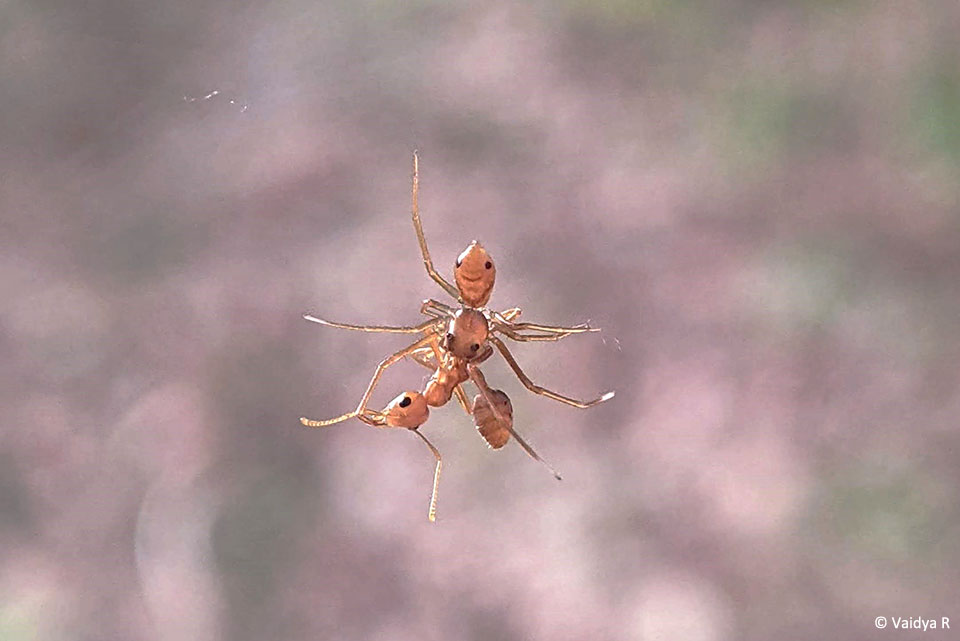
Amyciaea sp., an ant-mimicking crab spider feeding on a weaver ant
The paths are overgrown on each side with invasive Siam weed plants (Chromolaena odorata). Spiders don’t seem to be picky about where they show up. Social spiders (Stegodyphus sp.) weave their messy silks around these plants. A mason wasp decided to use this web to situate her nest to lay her egg, her ‘pot’. A monsoon storm a few days later, however, put paid to the web as well as the nest built on it.
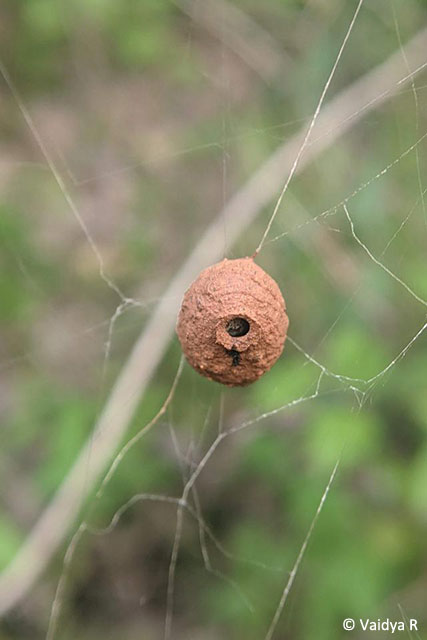
A mason wasp’s ‘pot’ nest, on a social spider web
By October, the paths are thicker with vegetation after the monsoons. Large webs of the giant orb-weaver (Nephila philipes) show up every dozen feet. Orb-weavers live most of their lives inside their webs which function as an extension of their sensory systems. A trapped fly triggers vibrations which the spiders sense and go capture them.
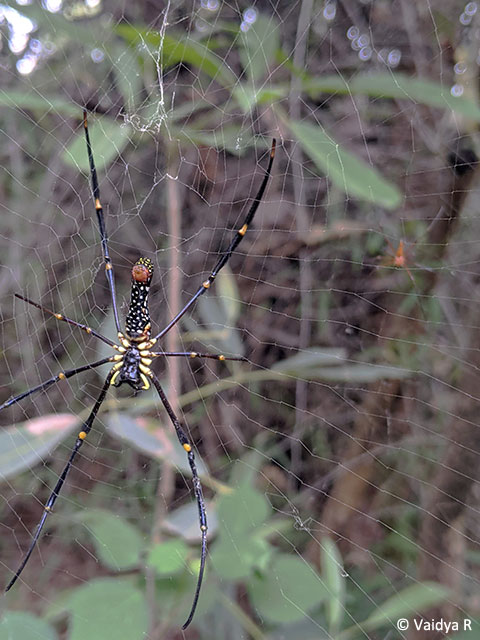
A female giant orb-weaver (Nephila philipes)
Sometimes these webs are low enough to reveal the numerous dew-drop spiders (Argyrodes sp) living off these spider webs. These are thieves who live off the bigger spider webs – kleptoparasites – as the literature calls them elegantly. And their thieving is nothing but elegant.
“From a nearby hiding place, it [Argyrodes] runs several lines of silk to the hub and spokes of a Nephila web, effectively plugging its sensory system into that of the bigger spider. Argyrodes acts carefully to avoid creating its own telltale vibrations. It runs only when the Nephila is moving and treads more slowly when the Nephila is still. It also holds on to any strands it cuts to avoid sudden releases in tension. Through such subterfuge, this thief is almost never caught. As many as 40 of them might be plugged into a single Nephila web.”
– Ed Yong in ‘An Immense World’
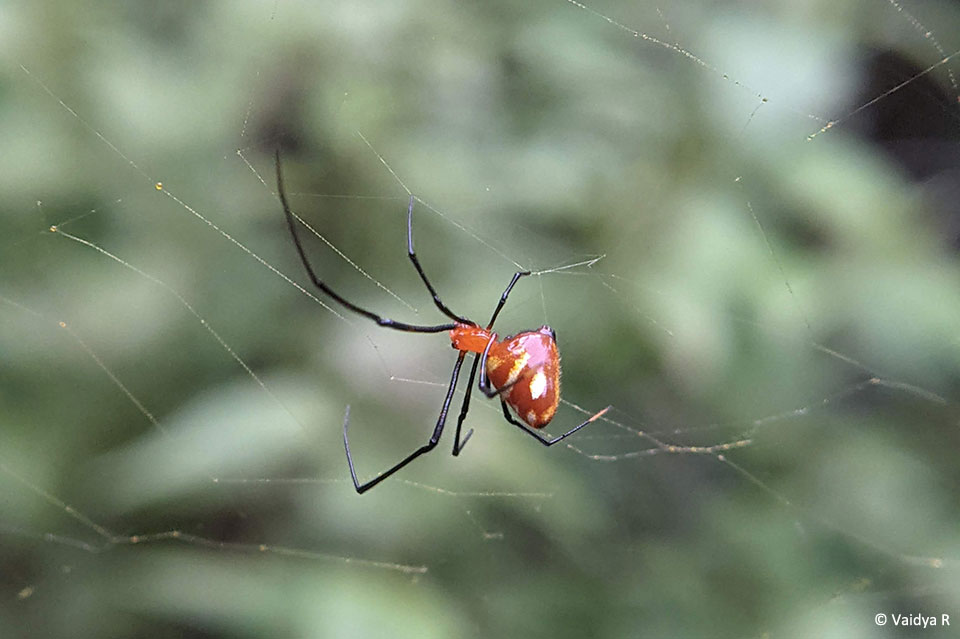
Dew-drop spiders (Argyrodes sp.) are kleptoparasites and live off the webs of giant orb-weavers
The end of the year is easily the best season to watch spiders. This is when they seem to put out more visible egg-sacs that can be seen hanging around them. An egg sac led me to my first observation of the elusive whip-spiders, Ariamnes sp.
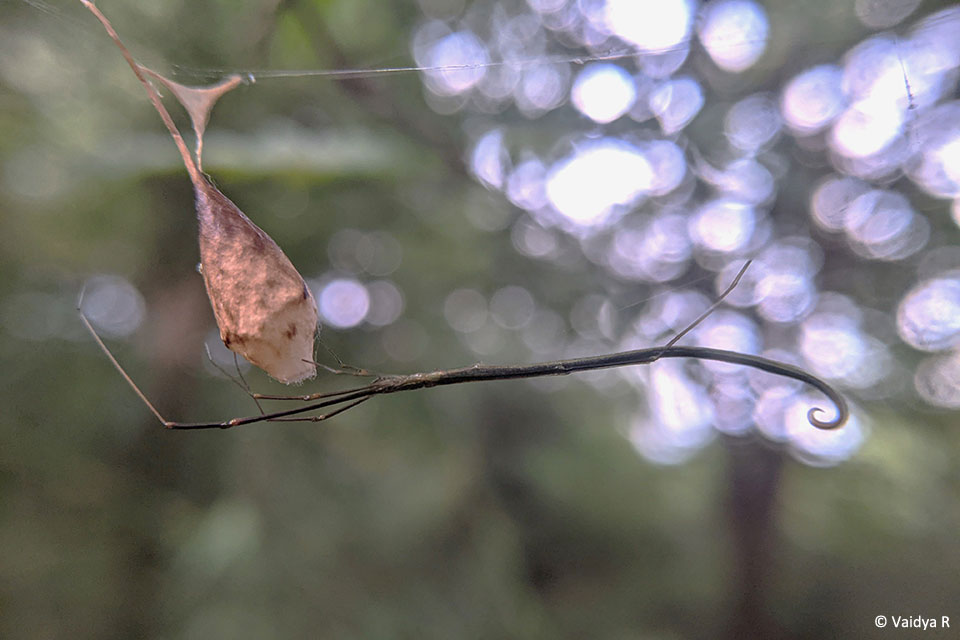
Whip-spiders (Ariamnes sp.) with an egg sac
The egg sac hatched, putting out young whip-spiders who hung around their mother’s web looking like a garland of em-dashes.
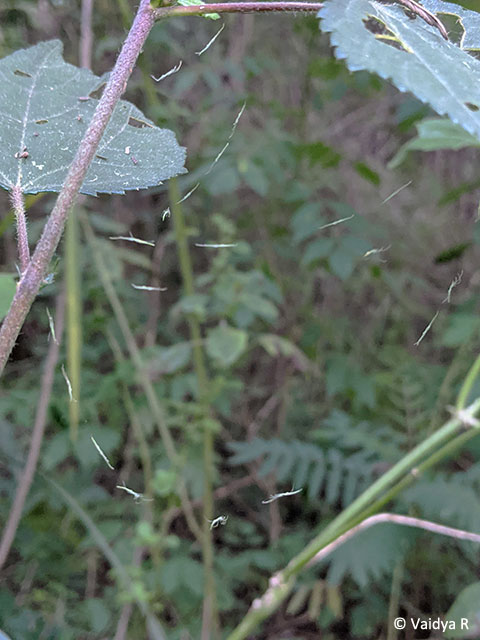
Newly hatched whip-spiders
Looking for more whip spiders also led me to my first sighting of scorpion-tailed spiders Arachnura sp. in Bangalore. I had seen them in semi-wild regions of South-Interior Karnataka and the Western Ghats, but a sighting in Bangalore had eluded me.
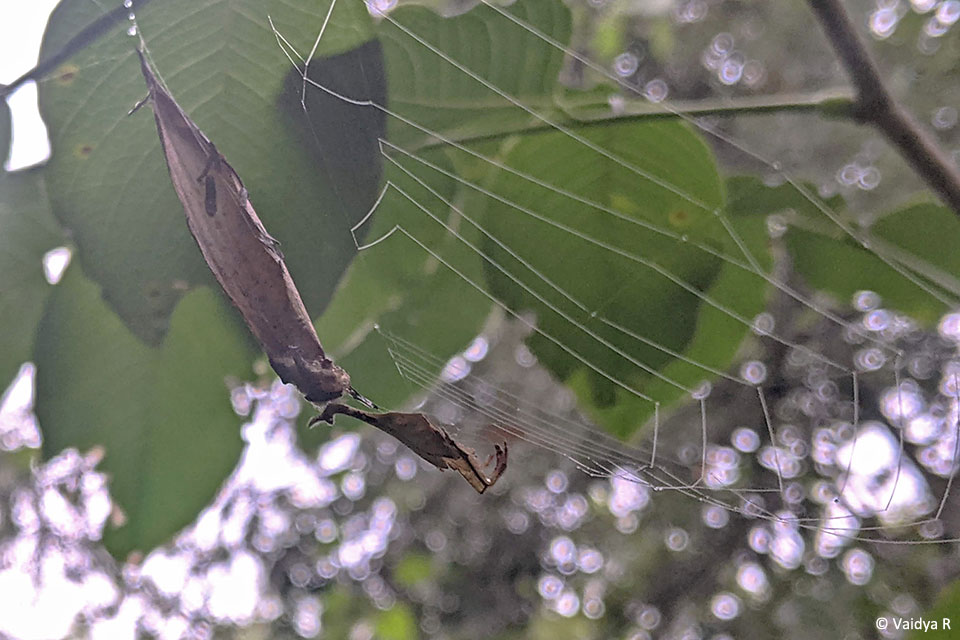
Scorpion-tailed spider (Arachnura sp.)
Some of the most elusive spiders are the jumping spiders of the family Salticidae. As much as I keep looking for them, they stay elusive. But sometimes a rare sighting happens and leaves you wanting for more. A lynx spider (Peucitia sp.) was spotted holding a prey which looked like a spider. Closer inspection revealed it to be a Chrysilla acerosa, a cousin of the more elusive and colourful Chrysilla volupe.
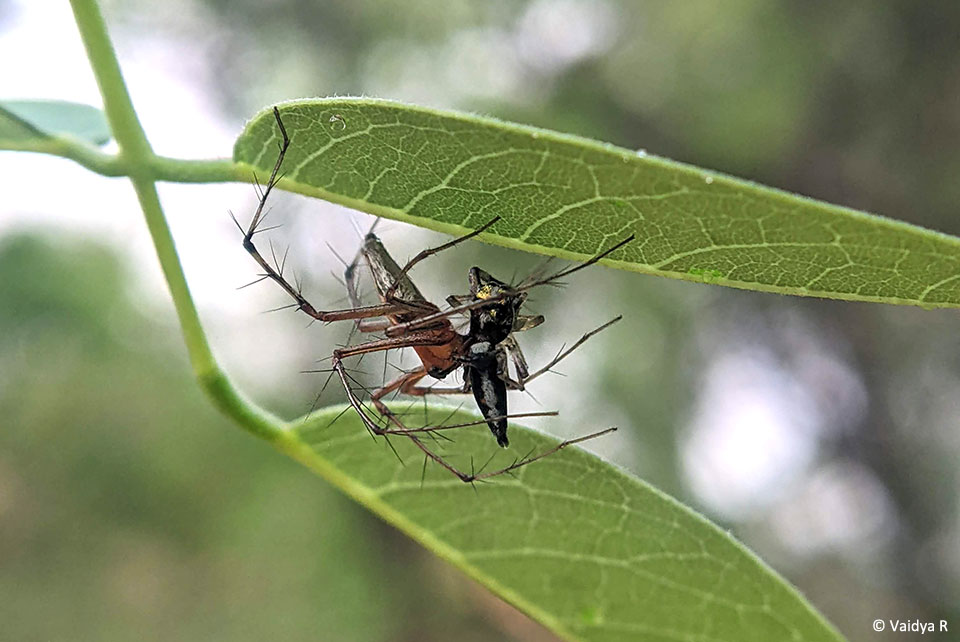
A lynx spider (Fam. Lycosidae) with its prey, a jumping spider (Chrysilla acerosa)
Apart from the list of species, what keeps you hooked is getting to see the different interactions and life stages of spiders. Like watching hatched spiderlings of Meotipa sp. hang around with their mother.
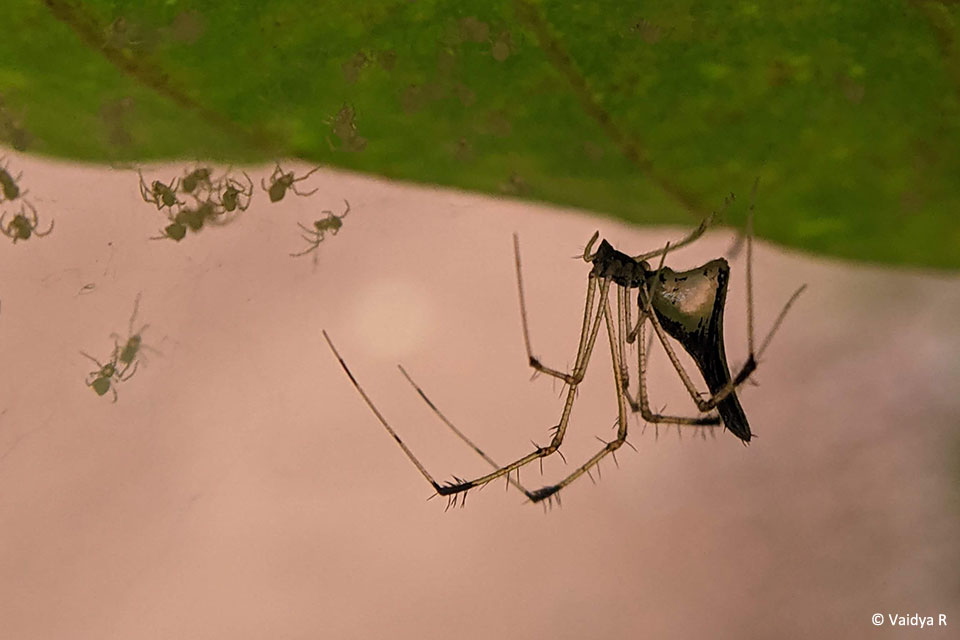
Spiderlings of Meotipa sp. with their mother
Or watching newly hatched spiderlings hang around their mothers’ gossamer webs.

Spiderlings in their mother’s web
Or a jumping spider Rhene sp. feeding on an Ornamental Tree Trunk spider.
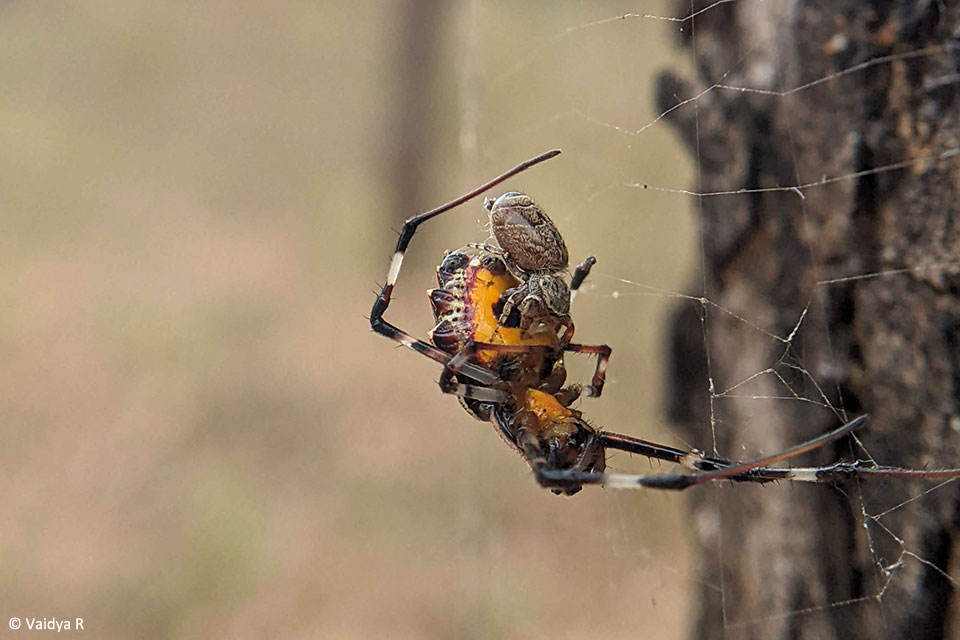
Jumping spider Rhene sp. with its prey, an Ornamental Tree Trunk spider
It has been more than a year of walking the paths of the bio-park for me. I feel more sure of where I am, and where each path leads. Having seen the different seasons of a year in one place, I feel like I have a little bit more understanding of the landscape. I lead friends on walks, telling them about where I saw which bird, and which spider – the landscape is dotted with landmarks of natural life.
Over the year I have also learnt that there is always more to a landscape than you can learn. You can live a lifetime in a place and still have it surprise you; a year is hardly a dot on the timeline. But I feel the vocabulary growing, I feel like I am able to converse with the landscape a little bit longer with time. Over time, if I stay and wait, I feel it might reveal more of its secrets to me. It might take years or decades, but it is a journey that I look forward to with hope.
“When we enter a landscape to learn something, we are obligated, I think, to pay attention, rather than constantly to pose questions. To approach a land as we would a person, by opening an intelligent conversation. And to stay in one place, to make of that one long observation, a fully dilated experience. We will always be rewarded if we give the land credit for more than we imagine, and if we imagine it as being more complex even than language. In these ways, we begin, I think, to find a home, to sense how to fit a place.”
– Barry Lopez

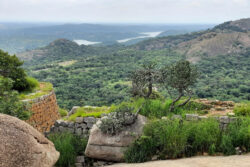
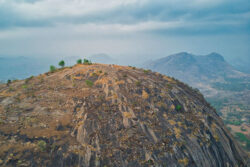
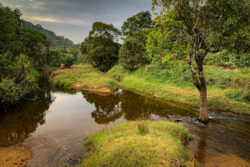

Instagram
junglelodgesjlr